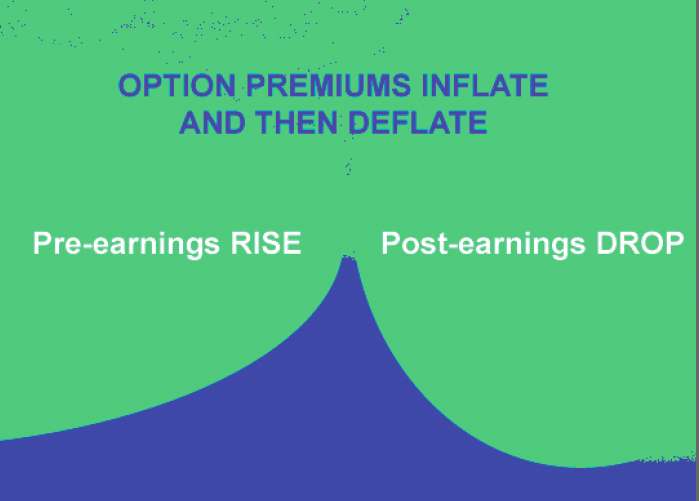 Four times a year--January, April, July, October--traders have a chance to make extra $$$ by playing the game of "volatility crush." As companies prepare to announce earnings, uncertainty about the direction of the stock causes the prices of options to increase. After the announcement, the uncertainty reduces and the premiums on options decreases. Here's my analogy: just as the incoming tide raises all boats, large and small, so the increase in volatility tends to inflate prices on most stocks, even on those who are not declaring earnings!
Four times a year--January, April, July, October--traders have a chance to make extra $$$ by playing the game of "volatility crush." As companies prepare to announce earnings, uncertainty about the direction of the stock causes the prices of options to increase. After the announcement, the uncertainty reduces and the premiums on options decreases. Here's my analogy: just as the incoming tide raises all boats, large and small, so the increase in volatility tends to inflate prices on most stocks, even on those who are not declaring earnings!
So lets look closer at this pattern.
Before earnings, traders expect an inflation of premiums of 10%, 20% or even 30%. After the announcement, premiums will return to approximately where they were before, or even lower. Instead of buying options at inflated process, smart traders will sell either before or soon after the announcement, and then buy back later. The difference will be profit.
Here are two strategies that work most of the time.
1. The "Earnings Crush!" Using the Wide-Wing Iron Condor
When the premiums are inflated, before the earnings are released, sell out-of-the-money Puts and Calls using an Iron Condor. Make sure the strikes you sell are well beyond the typical move of the stock after earnings. This is a non-directional trade that works 80-90% of the time, regardless of the direction of stock price movement. (Always buy a further out Put and Call as protection, and to limit your margin requirement.)
A good fisherman knows that he must wait for the biting fish, or else move his lure elsewhere. When putting on this strategy, I often ask for a little more money. I don't get it by using closer strikes but by going out another month. More time, more money means more safety. If the fish (buyers) don't bite at my credit read, oh, well! But they will bite at enough to create a profitable earnings season. I'm happy to get eight out of ten biting fish from line to boat. Two can escape and I'm happy!
2. The "After Earnings Slide" using Directional Credit Spreads
After earnings are declared, stocks will often gap up or down, signaling a clear direction for the traders. If direction is clear, we sell either a Put or Call spread at the pre-announcement close and expect the stock to stay away from our position. Once the stock reaches another turn, or seems to indicate a new trading range, we may then sell the remaining credit spread, resulting in a post-earnings Iron Condor.
If direction is unclear, and the stock just moves sideways, then a normal Iron Condor will do just fine!
How to Trade
So, how can options traders make money on this recurring pattern? As you will encounter these opportunities four times a year, I recommend that traders draw up a list of potential candidates for this trade, review the charts to establish trends and typical ranges of movement upon earnings for each stock.
About two weeks before the earnings announcement, enter a trade ticket for an Iron Condor at appropriate strikes at 20-30% above normal premiums, or at 80-90% probability OTM. Another way to go is to place your sold strikes 50% beyond the expected market maker move. As you see the premiums rise, adjust the asking price to obtain the maximum available credit. A day or two before the announcement, enter the trade at a fillable price. Once filled, set a buy-back price at 50% of what you sold the credits for.
After earnings, it takes four days on average for the volatility to go away and things return to normal with your stock. Close the trade when you are satisfied with the profit you have received.
Next quarter, earnings season will return, and you can do it all again! So keep records and compare each quarter until you become an expert in trading earnings season using Iron Condors.
Graeme says, "Opportunity is missed by most people because it is dressed in overalls and looks like work." Actually, it was Thomas A. Edison the famous inventor.
---------------------
Copyright 2014 Honolulu Options Traders, LLC
facebook.com/honoluluoptionstraders
meetup.com/honolulu-options-traders
